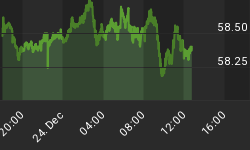No matter how shocking, violent, bloody, embarrassing, or expensive a major reversal is, within two weeks there is no one who didn't make the call.
Along with sharp reversals in the hot games, gold and silver suffered a hit. For a sound understanding of where the precious metals are heading, it is appropriate to review the action.
Our forecast has been that once the highs for this sector were set in the week centered on May 10, the slump would run into mid-June and silver would underperform gold.
Generally this has been the case and the volatility has been impressive.
Even more impressive to our historical approach is that once again a raging market for gold and silver replicated the pattern seen with the examples set in 1974 and 1980.
This was that during most of the boom the gold/silver ratio declined as silver outperformed. Then three weeks before the ultimate top for both, gold outperformed and the key was the reversal in the gold/silver ratio. This reversed on April 19, which placed the potential high at close to May 10.
Never mind using this to make the right call - at the climax of a remarkable boom, the ending pattern replicated itself.
This is worth reviewing. Many goldbugs have been paranoid about central bankers depressing the price of gold. This then focused a lot of power into the silver market, which proponents have been convinced it could be bulled for some considerable time.
As everyone knows, currency and interest rate manipulations are important and influential tools of interventionist policymakers.
The establishment remains convinced that most of what happens is due to policymakers. In which case, with so much influence on gold, interest rates, and currencies, how did they rig the action in precious metals to replicate the concluding pattern?
Of course, they didn't arrange this because they didn't know the pattern.
Clearly, this boom in commodities has been the biggest financial event since the stock bubble that blew out in 1Q 2000.
Part way down the subsequent collapse (actually, it was in January, 2001), previously supportive pundits discovered that the Nasdaq had given up some $3.5 trillion in market cap. The outrage needed a scapegoat and op-ed pieces in the Financial Post and WSJ, for example, blamed it on Greenspan's last increase to 6% in administered rates.
That bubble was a classic in replicating the pattern set with the first new era of financial speculation that blew out with the South Sea Bubble in June, 1720. The 6th such reliable pattern climaxed in March, 2000.
When measured in years, the pattern begins with the peak of the last business cycle in the "old" era of inflation. On the first example that was in 1711, the bubble ended nine years later in 1720.
The next one ran from 1763 to 1772, the next from 1816 to 1825, with continuing examples being 1864 to 1873 and 1920 to 1929.
Obviously, the nine-year run prevails and, when the data are known to the month, the pattern becomes even more intriguing.
Using the NBER history of expansions and contractions, the key peak was in January, 1920 and the stock bubble concluded in September, 1929. The duration of that new financial era was 116 months.
On the most recent example, the peak of the last business cycle with the "old" era of inflation was set in July, 1990 and the bubble climaxed in March, 2000.
The duration was also 116 months and the irony is that, in both cases, the establishment was convinced that the wonderful prosperity was easily managed by the Fed. Then, showing regrettable fickleness, a chagrined establishment then blamed the Fed for the fallout from a typical financial mania.
Naturally, the challenge to today's crowd of policywonkers - if the Fed is running the show, how did it replicate the new financial era pattern to 2000 with such fidelity? Particularly when they didn't know anything about this important aspect of financial history.
The irony is almost overwhelming as the main theory of intervention was crafted by Keynes, who was personally offended by the 1929 bust. Being long, he was, of course, not offended by the boom.
Of course, the next step is that the establishment has been controlling gold, interest rates, and currencies. How did they replicate the major climaxes in gold and silver?
Just asking - enough said.
Wrap: On the near term, the initial decline has been likely to run into mid-June.
On the longer term, recent action in the credit, commodity, and stock markets is likely defining a cyclical change towards a business contraction. In which case, gold will likely outperform most asset classes and, more specifically, silver.
The gold/silver ratio, which reversal at 43.6 on April 19 was critical, increased to 54.6 on Thursday. This, essentially, marked the first phase of forced selling of stocks and commodities.
The ratio has come in to yesterday's 51.2, which is a good test of the low. This decline in precious metals could continue into June and today's slight increase in the ratio could be signaling the next slide.
On the financial side, widening credit spreads is a plus for gold, but recent flattening of the treasury curve is a minus.
Through April, our advice was to lighten up n the senior gold and silver stocks in order to accumulate exploration stocks on the correction. Gold's real price is likely in a long term bull market.
















